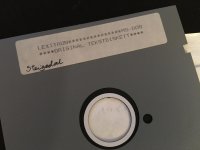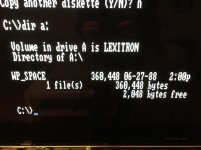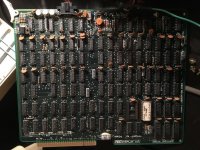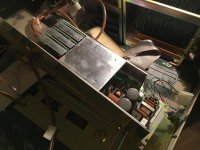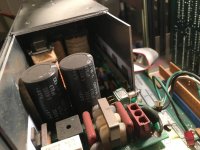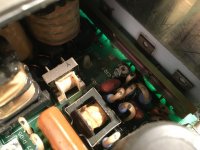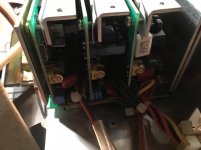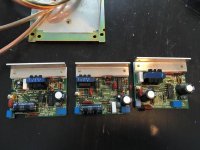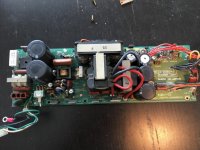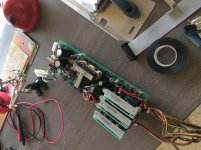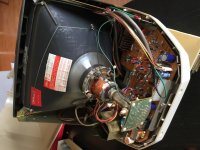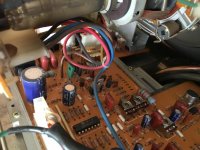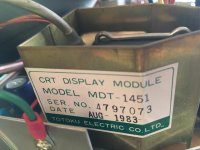mvno_subscriber
Experienced Member
Hello, first poster here.. Found this site while looking around for info on my new machine, and decided I had to post this (plus I'm a big vintage computer fan with no forum memberships, so why not!)
I recently got hold of a strange machine that it took some real google-fu to figure out what was. I was told by the seller that it booted, he sent me pictures and I took a leap of faith.. What I got was a blackened, smudgy piece that smelled like someone that hadn't had a bath for a very, very long time..
Anywho, I cleaned it up, opened it up, took some pictures and tried it out - with the exception of the second floppy drive which is making some clanking noises, it works great!
My internet info consisted of http://www.vintagecomputer.net/raytheon/VT302/ and http://www.vcfed.org/forum/archive/index.php/t-13089.html (someone posted here a long time ago, apparently - but thread seemed to die out).
So, based on this and on my usage of it + the manual that came with it:
Nah, let's get on with the pictures!
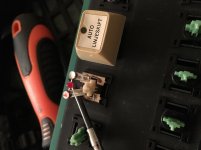

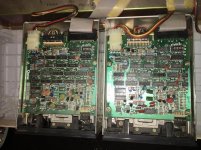

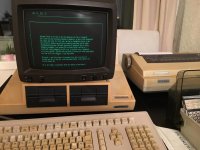
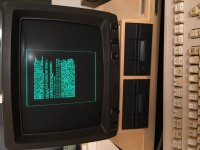
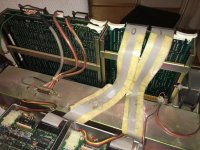
Neat things:
Hope this was fun to read.. and if anyone can help me out, that would also be really nice. Because right now, I'm stuck with a few questions:
Have a good one, and what a nice forum you've got here!
I recently got hold of a strange machine that it took some real google-fu to figure out what was. I was told by the seller that it booted, he sent me pictures and I took a leap of faith.. What I got was a blackened, smudgy piece that smelled like someone that hadn't had a bath for a very, very long time..
Anywho, I cleaned it up, opened it up, took some pictures and tried it out - with the exception of the second floppy drive which is making some clanking noises, it works great!
My internet info consisted of http://www.vintagecomputer.net/raytheon/VT302/ and http://www.vcfed.org/forum/archive/index.php/t-13089.html (someone posted here a long time ago, apparently - but thread seemed to die out).
So, based on this and on my usage of it + the manual that came with it:
- This is a word processing computer (i.e. not really intended for general purpose - although internet suggests it runs BASIC)
- Intel 8085 processor
- Custom, really neat display processor - scrolling of text is super smooth, and some changes like looking at the full page or switching cpi makes the monitor interpret the signal differently (see pictures)
- SCSI printer interface (that's what it looks like to me, at least)
- Only date code I found was on the keyboard, which says May 83.
- Raytheon is the same as Lexitron, which made other word processors with what seems to be the same software (manual is from '81 and uses a VT1202 for illustration)
Nah, let's get on with the pictures!







Neat things:
- The machine has an access panel in the back, so you can open it up and change logic boards without taking off everything
- The monitor is connected on a cable from inside the machine that's a bit tricky to remove and put in place.. I was careful when opening up, so thankfully nothing got broken

- Keyboard is REALLY comfortable - this is definitely meant to be a typing machine - also, there are tons of typing-specific keys on the keyboard. Wonder what switches those are As far as I know you didn't get Cherry switches at that time (05.83, when the keyboard chassis is timestamped)
- Disk drives are made by Qume - which also supplied the daisy wheel printer that came with it (computer says made in Japan, but disk drives are made in USA)
- When pressing the "full page" key, the monitor says "click" and apparently shows what I believe really is the entire video signal. When showing normal typing, it shows just a part of the page.
- Monitor has buttons to select print spacing, display spacing and character pitch - when switching to a lower character pitch, the monitor stretches the image horizontally to show less characters
- Changes are written to disk automatically - there is no manual save or undo. If you eject the disk, you get a warning beep and three seconds to insert it again. If not, document is cleared.
- As far as I know there is no soft reset - you're supposed to type on it, that's it. The manual says the computer can be left on all day with no problem.
- The monitor is extremely comfortable. No high pitched CRT noise, it seems to have some extra coating that makes it easier on the eyes (and most likely prevents phosphor burns as well)
- Scrolling is performed by arrow keys, but in an opposite (i.e. "modern") manner - you're moving the page, not the cursor, so up means move page up (= cursor down)
- There are at least three different ways to delete a character, but no way of a normal backspace (i.e. move cursor left, then delete character). The closest you have is similar to the DEL key on modern keyboards.
- You have a "direct mode" where you control the printer and the screen simultaneously. The printer types what you type, and when you move the page the printer does it as well - really cool!

Hope this was fun to read.. and if anyone can help me out, that would also be really nice. Because right now, I'm stuck with a few questions:
- How on earth can I get data off this thing? The only two connectors on the back are for the keyboard and the printer.
- What disk formats are used? Could I put some extra stuff here?
- Is it possible to still get ribbons for the printer? It's a Xerox branded cartidge, but I can't find any model number.
- Any tips on what could be the issue with the clanking disk drive? I'm a bit of a newbie on repair, so any tips would really be appreciated!
Have a good one, and what a nice forum you've got here!

